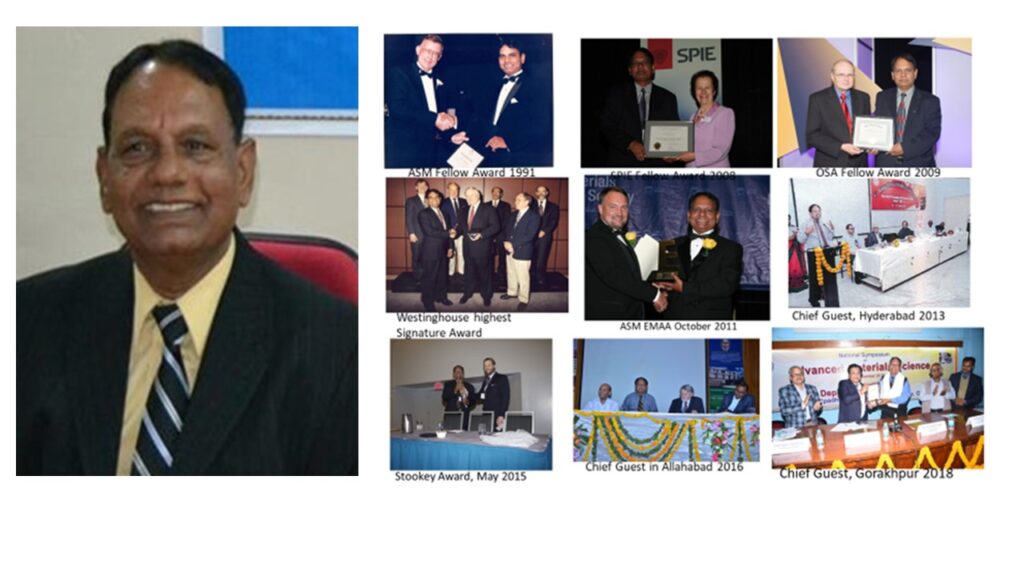Dr. N.B. Singh
University of Maryland, Baltimore County (UMBC)
Department of Chemistry/Biochemistry & Computer Science and Electrical Engineering
Friday, September 24, 2021
12:00 Noon
Evolution of Nanoengineered Materials: Electronic, Optical, Radiological, Bio and Energy Storage Applications
Recent efforts on bio-inspired materials have provided great inspirations for the design and development of nano engineered materials for variety of applications. The development of nanomaterials has great potential for lasers, IR and radiation sensors, high power electronics, lotus characteristics for variety of space and ground applications, bio-composites and clean energy storage for defense and commercial applications. The development of a room temperature MWIR and LWIR sensors will be huge a step for saving cost and weight to replace current cryocooled technologies. Current radiation sensors based on CZT crystals are costly and almost impossible for the protection of high value targets like bridges, airports, tunnels, and buildings and low cost sensors are much needed to replace low sensitivity scintillators. Nanoengineered lotus composites have attracted attention for the understanding of the surface behavior, interaction, wettability, and topographies of surfaces to remove impurities by self-cleaning from the devices and components and large surfaces. By designing unique composition, we have investigated composites to reduce degradation of bones for aging population, and also to understand the mechanism of kidney stone formations. Many countries including USA and India are developing solar energy and battery researches for clean energy. To meet the needs of storage, we will provide several examples of design, development of novel compounds and pathways for manufacturing of dielectric energy storage.
Prof. N. B. Singh of the Chemistry and Biochemistry, and Computer Science and Electrical Engineering department of the UMBC, a Fellow of the American Society of Materials (ASM), a Fellow of Society of Optics and Photonics (SPIE), Fellow of the Optical Society of America (OSA), and a Fellow of the Royal Society of Chemistry (RSC), is internationally famous for the leadership and researches. Before joining the UMBC, he served 29 years in Northrop Grumman as the Technical Director (Sr. Consulting Engineer, highest technical position). He has 25 patents, more than 220 journal papers, more than 87 plenaries, keynotes and invited lectures in national and international conferences, more than 120 conference papers, more than 250 corporate trade secrets. He has transitioned several defense technologies which are saving lives of USA and friendly forces. He has been honored with more than 30 international awards including, “Engineering Materials Achievement Award” of ASM for the “Development of Material for Hyperspectral
Imager for Homeland and Defense Applications”, Stookey International Award of the American Ceramic Society Glass & Optical Materials Division and the Deutsche Glastechnische Gesellschaft (GOMD-DGG) for “Innovation and Discovery”, Westinghouse “Corporate Signature Award” (highest corporate award) for “Development of Crystals for Passive Missile Warning Systems(PMAWS) and “Industry Week R&D Star Award” for pioneering research. Prof. Singh was honored by his selection in two different panels, “Materials and Processing” and “Electronics and Semiconductor Technologies” of the Vaibhav initiative of India by the Honorable Prime Minister of India.
Dr. Singh completed his B.Sc. (T. D. Post-Graduate ), M.Sc. and Ph.D. from Gorakhpur University. He taught and supervised Ph.D. students in T. D. Post Graduate College from 1971 to 1979. He joined the Westinghouse Electric Corporation (now Northrop Grumman) in 1984 as a Senior Engineer after university teaching and research at R. P. I. Troy, NY. He was promoted to Fellow in 1986, Advisory Engineer in 1989, and since then, he was continuously given increasing responsibilities until his retirement where he was Technical Director (Senior Consulting Engineer). Dr. Singh led the team to develop science requirements for several shuttle experiments of NASA including Northrop Grumman shuttle experiments. He was the chairman of the Gordon Conference on “Gravitational Effects on Materials” in 1993. Dr. Singh is an Associate Editor of the Progress in Crystal Growth and Characterization, and he is in the editorial board of several journals. He is editor of several proceedings of the conferences and three books. He has served as a referee for more than 30 journals. Dr. Singh served as an Executive Committee member of the American Association for Crystal Growth for 12 years, and the founder of the Pittsburgh Chapter (PCCG) and the Capital Chapter of Crystal Growers (CCCG). He is the founder of the Northrop Grumman Materials Corporate Forum which focuses on critical materials for defense. He served as a panel members of the National Academy of Sciences on the National Materials Advisory Board (NMAB) for many years. He taught Hindi, Science, and religion to children between ages of 4 to 15 years every Sunday at the Hindu Temples Pittsburgh and Baltimore since 1984 to 2017. He coached girls’ soccer and softball and the baseball teams for boys (up to pony league) for many years.
